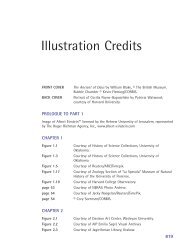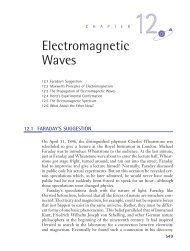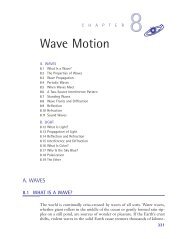Chapter 9: Einstein and Relativity Theory (319 KB) - D Cassidy Books
Chapter 9: Einstein and Relativity Theory (319 KB) - D Cassidy Books
Chapter 9: Einstein and Relativity Theory (319 KB) - D Cassidy Books
Create successful ePaper yourself
Turn your PDF publications into a flip-book with our unique Google optimized e-Paper software.
3637_<strong>Cassidy</strong>TX_09 6/14/02 12:08 PM Page 420<br />
420 9. EINSTEIN AND RELATIVITY THEORY<br />
A <strong>and</strong> away from B. On the other h<strong>and</strong>, John could argue just the reverse,<br />
that he is at rest <strong>and</strong> it is Jane who is moving.<br />
Which interpretation is correct There is no “correct” interpretation because<br />
there is no preferred frame of reference. Both observers are moving<br />
relative to each other. They can agree on what happened only if they agree<br />
on the frame of reference, but that agreement is purely arbitrary.<br />
The conclusion that the simultaneity of two events, such as two flashes<br />
from separate light bulbs, depends upon the motion of the observer, led to<br />
the possibility that time itself might also be a relative concept when examined<br />
in view of the relativity postulates.<br />
9.6 RELATIVITY OF TIME<br />
Let’s see what happens to the measurement of time when understood<br />
through special relativity.<br />
We’ll follow <strong>Einstein</strong>’s original argument <strong>and</strong> examine another, somewhat<br />
updated thought experiment. In this experiment one observer—again<br />
we’ll call her Jane—is in a spaceship moving at an extremely fast uniform<br />
speed relative to the Earth <strong>and</strong> in the horizontal direction relative to another<br />
observer, John, who is stationary on the Earth. In Jane’s spaceship<br />
(i.e., in her reference frame) there is a clock that measures time in precise<br />
intervals by using a laser pulse. The pulse travels straight up from a laser,<br />
hits a mirror, <strong>and</strong> is reflected back down. When the pulse returns to the<br />
starting point, it is detected by a photosensor, which then registers the<br />
elapsed time t, a fraction of a second, say, 10 7 s, <strong>and</strong> emits another pulse<br />
upward. Since the speed of light is constant <strong>and</strong> the distance that it travels<br />
is fixed, it takes the second pulse the exact same amount of time to make<br />
the round trip. So another 10 7 s is registered by the detector. These identical<br />
time intervals are used as a clock to keep time.<br />
Since Jane is traveling at uniform velocity, <strong>Einstein</strong>’s Principle of Rela-<br />
Mirror<br />
d<br />
Laser beam<br />
FIGURE 9.9 Laser clock in spaceship (as seen<br />
from spaceship frame of reference).<br />
Detector






